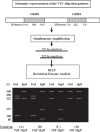Analysis of enzymatic digestion pattern of two open reading frames of Varciella-Zoster genome from Kuwaiti patients using the RFLP technique
- PMID: 23205251
- PMCID: PMC3507309
Analysis of enzymatic digestion pattern of two open reading frames of Varciella-Zoster genome from Kuwaiti patients using the RFLP technique
Abstract
Background and objectives: Varicella-Zoster virus (VZV) is a human herpes virus that usually attacks young children and commonly causes chicken pox (Varicella). Following primary infection, a lifelong latent infection is established. The virus often reactivates during adulthood or senesces to cause shingles (Zoster). Little is known regarding the genotypes of Varicella in Kuwait. The aim of this study was to genotype Varicella samples collected from patients in Kuwait.
Materials and methods: Samples from 60 cases of chicken pox were typed. The DNA extraction was performed using the commercially available DNA extraction kit. Two sets of oligonucleotide primers were used to amplify the intervening sequences with polymerase chain reaction to identify VZV DNA in clinical samples. The BglI and PstI endonucleases were used to digest. The PCR amplicons for PCR-RFLP typing.
Results: Relatively consistent restriction enzyme digestion profiles for different VZV strains were observed. Limited genetic differences between VZV samples were found. Three VZV strains were identified (A, B and C) with type B representing 86.6%, type A 11.7% and type C being 1.7%. We found that distinct restriction fragment length polymorphism isolates from the same origin or nationality were very similar.
Conclusion: Varicella strains with cutting sites for both enzyme PstI and BglI (typeB) were more prevalent. Molecular amplification of viral DNA by PCR and restriction digestion could be used for VZV typing as an alternative method to serological assays.
Keywords: Genotyping; Kuwait; RFLP; Restriction enzymes; Varicella.
Figures


Similar articles
-
Molecular characterisation of varicella-zoster virus strains in Germany and differentiation from the Oka vaccine strain.J Med Virol. 2003 Oct;71(2):313-9. doi: 10.1002/jmv.10485. J Med Virol. 2003. PMID: 12938208
-
Enzymatic Digestion Pattern of Varicella Zoster Virus ORF38 and ORF54 in Chickenpox Patients Using RFLP Technique.Iran J Pathol. 2016 Winter;11(1):35-40. Iran J Pathol. 2016. PMID: 26870141 Free PMC article.
-
Nationwide distribution of varicella-zoster virus clades in China.BMC Infect Dis. 2016 Oct 7;16(1):542. doi: 10.1186/s12879-016-1863-x. BMC Infect Dis. 2016. PMID: 27717328 Free PMC article.
-
Varicella-zoster virus.Clin Microbiol Rev. 1996 Jul;9(3):361-81. doi: 10.1128/CMR.9.3.361. Clin Microbiol Rev. 1996. PMID: 8809466 Free PMC article. Review.
-
Varicella virus-mononuclear cell interaction.Adv Virus Res. 2003;62:1-17. doi: 10.1016/s0065-3527(03)62001-4. Adv Virus Res. 2003. PMID: 14719363 Review.
Cited by
-
Varicella infection in the Middle East: Prevalence, complications, and vaccination.J Res Med Sci. 2018 Apr 26;23:19. doi: 10.4103/jrms.JRMS_979_17. eCollection 2018. J Res Med Sci. 2018. PMID: 29887897 Free PMC article. Review.
References
-
- Davison AJ, Scott JE. The complete DNA sequence of varicella-zoster virus. J Gen Virol. 1986;67:1759–1816. - PubMed
-
- Hayakawa Y, Yamamoto T, Yamanishi K, Takahashi M. Analysis of varicella-zoster virus DNAs of clinical isolates by endonuclease HpaI. J Gen Virol. 1986;67:1817–1829. - PubMed
-
- Straus SE, Hay J, Smith H, Owens J. Genome differences among varicella-zoster virus isolates. J Genl Virol. 1983;64:1031–1041. - PubMed
LinkOut - more resources
Full Text Sources
